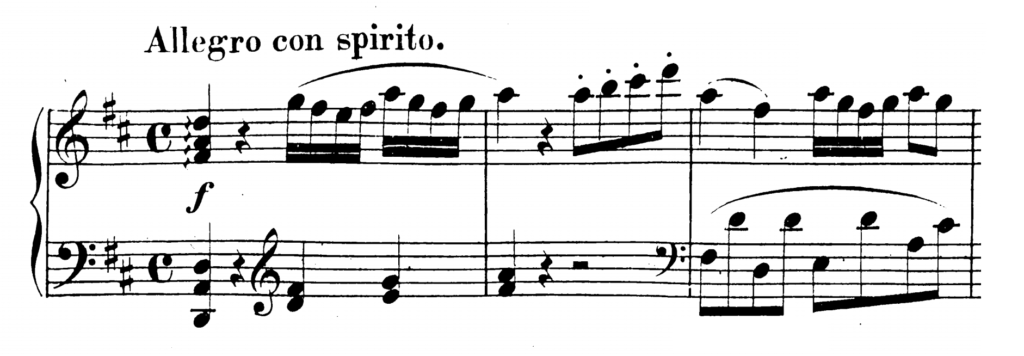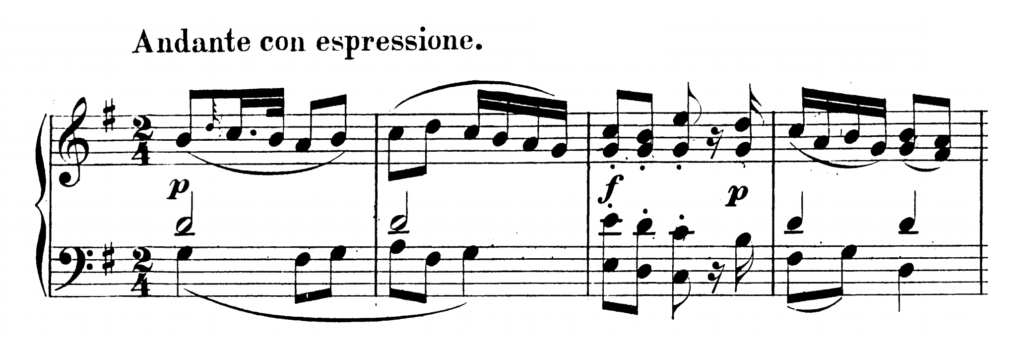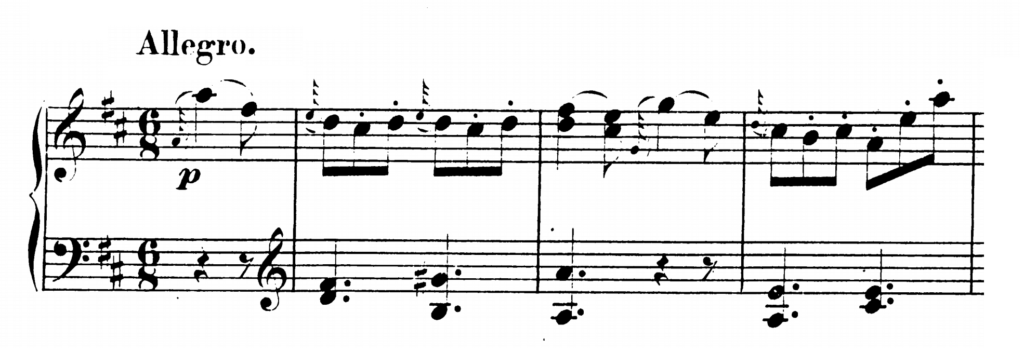Analysis
Contents
First Movement (Allegro Con Spirito)
Form: Sonata Form. D Major.
EXPOSITION:
Bars 1-7: First Subject in Tonic. The first subject is only seven bars in length. It is an eight bar sentence contracted to seven by overlapping of the two phrases in Bar 4.
Bars 7-16: Bridge-passage or Transition (overlapping). The transition overlaps the first subject. In Bar 11 the semiquaver (sixteenth note) figures are transferred to the treble. The passage is entirely in the key of the tonic, which it ends on a half-cadence, Bar 16.
Bars 16-36: Second Subject in A major (Dominant). The second section, in the key of A major (the dominant), is divided into two section, each ending with a perfect cadence. The first section (Bars 16-24) is an eight-bar sentence consisting of two four-bar phrases, the second of which is a modified repetition of the first, altered so as to close on a full, instead of on a half, cadence. The second section (Bars 24-36) is of great importance, as the principal portion of it (Bars 28-36) appears in the development transposed en masse into the key of G major. The opening four bars (24-28) consist simply of repetition of one motive. Starting in the left hand part this motive, though always containing the same notes, is sounding at each repetition at a different pitch. In Bar 26 the parts are inverted, but by their crossing in Bar 27 they become re-inverted. Bars 28-36, above referred to, form a melody in two-bar rhythm in which not only are the third and fourth phrases a repetition of the first and second; but all four phrases commence alike with the same opening three notes.
Bars 36-39: Codetta. Bars 36-39 form part of a small, but very important, codetta. They are founded on the slurred quavers (eighth notes) in Bar 29 and form the source from which the first eighteen bars of the development are developed.
Double bar and repeat.
DEVELOPMENT:
Bars 40-78: As just mentioned, the development starts with eighteen bars developed from the codetta; in this passage imitation appears in nearly every bar. Bars 44-47, in D major, are in sequence to the previous four bars which are in E minor, and Bars 50-51 are freely sequential to Bars 48-49, the music modulating to B minor, in which key, after incidentally touching G major, there is a perfect cadence in Bar 55. In Bars 56-57 it modulates definitely to G major, into which key the greater part of the second section of the second subject now appears transposed (Bars 58-66). The remainder of the development is derived from the transition, the last few bars being identical; the rhythm in the bass of the earlier portion of this passage, however (Bar 66, etc) is probably suggested by that in Bar 36. Note the chord of the augmented sixth in B minor, Bar 52.
RECAPITULATION:
Bars 78-99: Second Subject in Tonic. A noteworthy feature of this movement as regards to its form, is the exceptional recapitulation of the second subject before the first. The modulation to the tonic minor (Bars 83-86) should be noted, and also that here the first section of the second subject (Bars 78-86) ends on a half-cadence in the minor, approached through the chord of the augmented sixth, instead of on a full cadence in the major, as in the exposition. Still another point which differs in the recapitulation of this subject is that there is an interval of nearly half a bar between the two sections. In the bass this interval is filled by a link of a few notes. The second subject spans Bars 87-99.
Bars 99-105: First Subject in Tonic. The first subject reappears immediately after the second subject, overlapping it.
Bars 105-112: Coda. The short coda ends with a repetition of the final bars of the exposition, transposed into the key of the tonic.
Second Movement (Andante Con Espressione)
Form: Modified Rondo-Sonata Form. G Major.
PART I:
Bars 1-12: Principle Subject (first entry). The principle subject is an eight-bar sentence, extended, by cadential repetition, to Bar 12.
Double bar and repeat (at the end of Bar 11).
Bars 12-16: Transition. These bars start in E minor and modulate to D major and A major, the tonic of A, however, being immediately quitted as the dominant in D major, in which the second subject occurs.
Bars 16-38: Second Subject. The second subject commences with a new melody in D major (Dominant) (Bars 16-24), followed by a second portion commencing with a reference to Principle Subject, now in D major (Bars 25-38). Bars 27-28 are an inversion of Bars 25-26. Bars 29-32, repeated slightly modified in Bars 33-36, form a short sequential passage, with transient modulation through B minor, G major, and E minor back to D major, and lead to a full cadence in D, Bar 38, with which this episode closes.
Bars 39-50: Principle Subject (second entry), slightly varied.
PART II:
Bars 50-52: Link. There is no middle part of this movement; Bars 50-52 form a link leading to Part III. The previous link (Bars 12-16) is repeated here, but contracted to two bars. It consists of the chord of the Italian sixth resolving on to the chord of the dominant in G major.
PART III:
Bars 52-74: Second Subject. Part III commences with a repetition of the second subject (transposed into the tonic key) instead of the Principle subject. As there is no middle part, the third entry of the principle subject at the beginning of Part II is not necessary.
Bars 75-90: Principle Subject (third entry), lengthened, and again slightly varied. At the final entry the principle subject is varied by further ornamentation, and is considerably lengthened by cadential repetitions.
Bars 90-93: Coda.
Third Movement (Rondo)
Form: Rondo Form. D Major.
PART I:
Bars 1-16: Principle Subject in Tonic (first entry).
Bars 16-26: Accessory bars to Principle Subject.
Bars 26-40: Transition.
Bars 41-83: Second Subject in A major (Dominant). The first section of the second subject consists of a sixteen-bar sentence in four-bar rhythm. There is a half cadence in the eighth bar, followed by a variation of the first half the sentence, modified also to end with a full, instead of half, cadence. In this section, however, a special point to notice is the imitation of the opening motive in the bass of Bars 42-43, and 50-51. The second section consists of an eight-bar sentence which is repeated, the repetition being prolonged by cadential extensions lying both within, and beyond the cadence.
Bars 83-85: Link leading to re-appearance of Principle Subject.
Bars 86-102: Principle Subject in Tonic (second Entry). Complete re-entry of the principle subject in the key of the tonic.
Bars 102-119: Transition leading to Episode in B minor. This passage is founded on the first portion of the transition. It modulates and leads into the episodes in B minor and G major. In Bars 112-119, the preceding cadence is transposed, successively, into E minor and D major, and then – converted into a half-cadence – into the key of B minor.
PART II:
Bars 119-154: Episodes in the keys of B minor and G major. The episode commences with a melody in B minor, ending on a half-cadence, Bar 126, after which the same melody is repeated, inverted and lengthened, ending this time on a half-cadence in G major, Bar 138. A second melody, founded however on the second part of the first melody follows in the latter key.
Bars 154-173: Transition leading to re-appearance of Principle Subject in tonic key. Opening in similar to the one that precedes the episodes, it modulates from G major, to E minor, D major, and A major to D major, and ends, after a short pedal on A, with a cadenza leading to the recapitulation of the principle subject.
Double Bar.
PART III:
Bars 173-189: Principle Subject in Tonic (third entry).
Bars 189-205: Passage of Transition. The transition is modified, so as to lead into the second subject in the key of the tonic.
Bars 206-244: Second Subject in D major (tonic).
Bars 244-248: Link leading to re-appearance of Principle Subject.
Bars 248-256: Principle Subject in Tonic (fourth entry).
Bars 256-266: Accessory bars to Principle Subject.
Bars 266-269: Coda. The coda references the first portion of the transition, prolonged by cadential repetition.









